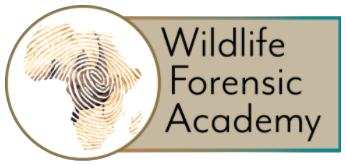
Advancing wildlife forensics is key to improving investigations, identifying perpetrators, and ensuring justice in the fight against illegal wildlife trade and environmental crimes.
RESEARCH STREAMS
FORENSIC ANALYSIS
Dactyloscopy
Research in dactyloscopy focuses on enhancing forensic techniques to support investigations into the illegal trafficking of animal products. This includes improving methods for detecting and recovering fingerprints from various wildlife materials and surfaces commonly encountered in trafficking cases. These advancements aim to strengthen law enforcement's ability to link suspects to wildlife crimes and bolster broader efforts against illegal wildlife trade.
Bloodstain Pattern and Aging Analysis
Bloodstain pattern analysis is employed to reconstruct the sequence and nature of events at wildlife crime scenes. In parallel, aging analysis of biological samples such as blood and tissue is being refined to estimate the time since deposition. Together, these tools contribute to temporal reconstructions of wildlife offenses and help establish stronger links between evidence and suspects.
Post-Mortem Interval (PMI) Research
PMI research aims to develop reliable techniques for estimating the time of death in animals involved in wildlife crimes. This involves studying biological and environmental factors, including decomposition rates, bloodstain characteristics, insect activity (entomology), and other forensic markers. Supporting this effort is a dedicated wildlife taphonomy facility on the property, where research into taphonomic processes and forensic entomology is conducted to improve PMI estimations under varied environmental conditions.
DNA and Isotope Analysis
Forensic DNA analysis is advancing methods for species identification and individualization in wildlife investigations. This includes developing efficient DNA sampling techniques from evidence sources such as vehicles, vessels, and clothing. In addition, stable isotope analysis is used to determine the geographic origin of animals or animal-derived materials, supporting the tracing of illegal trade routes and verifying the provenance of wildlife specimens.
WILDLIFE CRIME AND CRIME SCENE INTELLIGENCE
Research in wildlife crime scene management focuses on developing advanced methods for the detection, documentation, and analysis of evidence in wildlife-related offenses. Emphasis is placed on improving protocols for managing complex and often remote crime scenes, with integrated approaches drawing on entomology, decomposition studies, trauma analysis, pathology as well as trace evidence visualization and recovery.
A key area of innovation involves the development of cutting-edge technologies and tools to support real-time evidence tracking and identification in challenging environments, such as those involving shipping containers or field-based poaching incidents. This includes the application of digital mapping, remote sensing, and forensic imaging to enhance scene assessment and evidence collection.
In parallel, research is driving the creation of realistic simulation-based training platforms for law enforcement and conservation personnel. These tools are designed to replicate high-risk wildlife trafficking scenarios, providing immersive, scenario-based learning to improve investigative responses. Through the integration of forensic science, field technology, and capacity-building tools, this research enhances the effectiveness of wildlife crime investigations and contributes to the global fight against the illegal wildlife trade.
WILDLIFE FORENSIC PATHOLOGY AND ZOONOSES
Research in wildlife forensic pathology focuses on developing methods to accurately assess and identify injuries, diseases, and other conditions in both wild and domestic animals. This includes creating diagnostic tools and reference guides for identifying trauma, pathologies, and species-specific anatomical and physiological features. Techniques are also being refined for detecting diseases, contaminants, and toxicological markers in animal specimens to support forensic investigations.
An important component of this research involves studying zoonotic diseases - those transmissible between animals and humans. This includes the detection and analysis of pathogens within wildlife populations that may pose public health risks, particularly in the context of illegal wildlife trade and human-wildlife interaction. Understanding these transmission pathways supports efforts to prevent future outbreaks and enhances biosecurity measures.
Additionally, the research explores innovative approaches for quantifying trace substances in animal tissues, such as heavy metals, toxins, and veterinary pharmaceuticals. These advancements improve the precision and reliability of forensic analyses, contributing not only to wildlife crime investigations but also to broader efforts in animal health monitoring and assessing environmental impacts on wildlife populations.
ECOLOGY, CONSERVATION, EDUCATION AND LEADERSHIP
This research theme focuses on advancing ecological understanding and conservation strategies to protect wildlife populations and their habitats. It includes field-based and analytical research into species behaviour, population dynamics, ecosystem interactions, and the impacts of human activity, such as habitat loss, climate change, and wildlife trafficking. By generating data-driven insights, this research supports the development of effective, science-based conservation interventions.
A key pillar of this theme is education and capacity building, targeting both students and professionals. Research in this area explores innovative, evidence-informed approaches to teaching wildlife science, forensic investigation, and conservation policy. This includes developing immersive training programs, field-based learning modules, and digital educational tools that equip learners with practical skills in wildlife research, management, and enforcement.
In parallel, the theme supports leadership development by fostering interdisciplinary collaboration and empowering the next generation of conservation leaders. This involves mentorship programs, stakeholder engagement initiatives, and leadership training tailored to the unique challenges of wildlife conservation and policy implementation. By integrating ecological research with education and leadership, this theme aims to create a globally informed, ethically grounded, and action-oriented community capable of driving sustainable change for wildlife and ecosystems.




